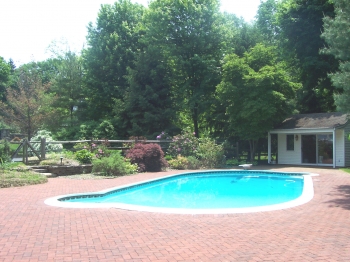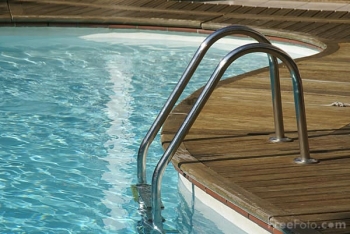In the Buddhist tradition, there is abundant literature on Walking Meditation. The reason is obvious. Walking does not require any tools, or preparation or expensive capital investment. This would be the ideal choice for monks who would normally live a simple life in a simple environment. But apart from walking, we can practise Mindful Meditation while going about a lot of other everyday activities.
Nowadays, swimming has become a popular pastime for many. Go to any public or private swimming pool, and you will note that at different times of the day, there are regulars who go almost every day at around the same time and spend a certain period of time swimming. Many of them will tell you that they have been doing it for years and that if circumstances prevent them from doing it on any one day, they will feel very uncomfortable and “incomplete”. I know of a group of people who swim every morning in a private club swimming pool in Hong Kong. They all attest to the benefit of regular swimming: better physical health and increased immunity to minor ailments etc. Most of them swim just before going to work in the morning and they claim that after the swim, they feel refreshed and ready to meet the day’s challenge.
So, what is happening here?
Recreational swimming is a very lonely game. There is no opponent or partner to play with you, and you cannot carry on a conversation or communicate with other people while you are doing it. What these swimmers do every day is, in fact, spend a certain period of time alone with themselves. For some people, it is a time to concentrate just on doing something and forget the world for a while. For others, it may be a time for reflection and may be for making plans for the rest of the day. What I have found, however, is that swimming is a perfect way to practise Vipassana Meditation and work towards the development of Mindfulness.
The following is a description of how Mindful Meditation can be done while swimming. This would be especially useful for those people who are regular swimmers and who would like to make use of this routine to help them to develop a fuller life.
The following is a description of how Mindful Meditation can be done while swimming. This would be especially useful for those people who are regular swimmers and who would like to make use of this routine to help them to develop a fuller life.
The pre-requisite
To swim, you obviously need a swimming pool. To have one’s own private swimming pool is obviously ideal. However, swimming in a public or private club pool would be equally feasible. The most important thing is to find a time when you can swim undisturbed along a lane in the pool. This may mean starting when the pool opens first thing in the morning or when the crowd is gone after peak hours. Another pre-requisite is that you must be a reasonably experienced swimmer who can perform the breaststroke slowly without worrying about the mechanics of the breast stroke.
The mechanics of swimming meditation
The most ideal way to swim and meditate is to use the breast stroke because this swimming stroke allows you to swim relatively slowly and deliberately.
To start with, one must get into the pool slowly and deliberately from the shallow end. You may first note the intention of getting into the pool and then note every movement of the body muscle and limb that get you into it. This would provide a good initiation into a Mindful state.
Once into the pool, you can note the coolness of the water around your legs and the sensation of the slight ripples of the water brushing against your skin. Stand for a few minute, feeling the sensation.
When you are ready, note first the intention of going into the water, then take a deep breath and slowly lower your head into the water and then slide your whole body into it. When you slide into the water, put you two hands together with the palms together and extend you arms straight in front of your head (which would be under water) and stretch them forward as far a possible. At the same time, you can use your feet to pushing against the side of the pool so that it can give you the momentum to glide through the water.
Let yourself glide forward slowly for a few moments with you hands and feet fully extended and your whole body in one straight line. Feel the sensation of water rushing through your hair and brushing your face and then the rest of the body in a gentle caress. At the same time, exhale slowly through you mouth by pursing your lips and feel the water bubbles that you blow out frothing against your face.
When you feel that the forward momentum of your body is coming to an end, perform the traditional breaststroke by pushing your arms straight out sideways while pressing your palms downwards. Feel the weight of the water against your arms and palms. Then bending your elbows, bring them to the sides of your body and bring your palms together towards your chest. Feel the movements of your arm and shoulder muscles and joints as you do this. As you press your elbows and pull your upper arms to the sides of your body, feel the pressure of the water that you have scooped pushing your upper body up the water. Inhale while your head is up. Feel the different sensations of air and water on your face. As the upward push loses momentum, let your head slide back down the water.
Form the intention of extending your arms straight in front of you again. At the same time, bend your knees and bring them together as if you would kneel with your heels facing skywards. Then in a kick, stretch and extend your legs outwards, then straight behind you again. Feel the forward momentum created by the kick of your legs as you glide silently through the water with arms and legs outstretched and your body in a straight line again. Again note the sensation of water rushing through your hair and brushing against your body as you glide. Very slowly exhale as you let the forward momentum run its course. Repeat this series of movements as you move forward in the pool.
When you reach the other side of the pool, touch the wall of the side and turn your body mindfully, noting first the intention, then the body movements required to move you around to swim back to the shallow end of the pool.
The Meditation
After a bit of practice, you should know the number of strokes you need to swim from one end of the pool to the other. For the average swimmer in a 25 metre standard pool, it can be anything between 8 to 13 strokes depending on your physique. Try to note this number because it may become useful in your meditation.
For the beginner, the easiest way to reach a certain degree of concentration is to count your strokes as you swim. Thus as you push your body to glide in the water, count silently: “one…” until the next stroke when you count “two…” etc, while you glide in the water again with your body in one straight line. After a little while, you will find your mind wandering off to other things, like the person swimming beside you, or some noise that you hear while your head is above water. Try to note these thoughts and bring yourself gently back to the number counting and the alternate sensations of water and air on your skin, the silence under water and movements of the different body muscles as you swim.
Once you have mastered the mechanics of swimming meditation, the next step is to concentrate on the breathing. When you inhale with your head above water, note the fact that you are inhaling and the movement of your chest wall and abdomen while you are doing it. Try to imagine the air going through your whole body. Then as you immerse your head under water, exhale slowly through your nostrils or mouth and note the fact that you are exhaling. Thus you concentrate your thoughts just on the breathing: “I am breathing in slowly…” and then “I am breathing out slowly…” You may also want to note the short momentary pause in between each inhalation and exhalation.
You should swim for at least 45 minutes in this manner. You will find that when you first start, your concentration will be very good, but after a while, your mind will wander off. You should note these thoughts without judgment and then gently bring yourself back to the breathing. Over the period of 45 minutes, your mind may sometimes behave much like a monkey with its tail on fire. But gradually with practice, you will gain a deeper and deeper level of concentration and you become just aware of the breathing and nothing else for a progressively longer period of time.
















